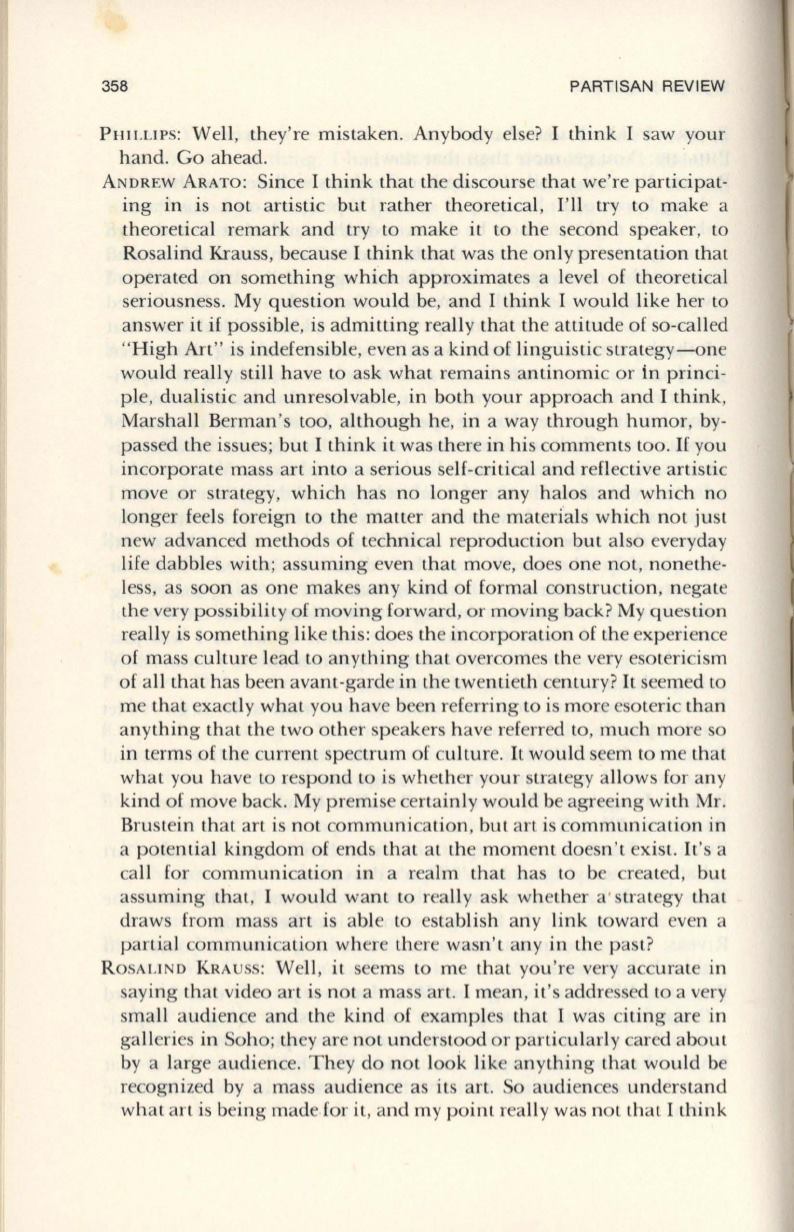
358
PARTISAN REVIEW
PHILLIPS: Well, they 're mistaken. Anybody else? I think I saw your
hand. Go ahead.
ANDREW ARATa: Since I think that the discourse that we're participat–
ing in is not artistic but rather theoretical, I'll try to make a
theoretical remark and try to make it to the second speaker, to
Rosalind Krauss, because I think that was the only presentation that
operated on something which approximates a level of theoretical
seriousness . My question would be, and I think I wou ld like her to
answer it if possible, is admitting really that the attitude of so-called
"High Art" is indefensible, even as a kind of linguistic strategy - one
would really still have to ask what remains antinomic or in princi–
ple, dualistic and unresolvable, in both your approach and I think,
Marshall Berman's too, although he, in a way through humor, by–
passed the issues; but I think it was there in his comments too.
If
you
incorporate mass art into a serious self-critical and reflective artistic
move or strategy, which has no longer any halos and which no
longer feels foreign to the matter and the materIals which not just
new advanced methods of technical reproduction but also everyday
life dabbles with; assuming even that move, does one not, nonethe–
less, as soon as one makes any kind of formal construction, negate
the very possibility of moving forward , or moving back? My question
really is something like this: does the incorporation of the experience
of mass cu lture lead to anything that overcomes the very esotericism
of all that has been avant-garde in the twentieth century? It seemed to
me that exactly what you have been referring to is more esoteric than
anything that the two other speakers have referred to, much more so
in terms of the current spectrum of cu lture.
It
would seem to me that
what you have to respond to is whether your strategy allows for any
kind of move back. My premise certainly would be agreeing with Mr.
Brustein that art is not communication, but art is communication in
a potential kingdom of ends that at the moment doesn't exist. It's a
call for communication in a realm that has to be created, but
assuming that, I would want to really ask whether a ' strategy that
draws from mass art is able to establish any link toward even a
partial communication where there wasn 't any in the past?
ROSALIND KRAUSS: Well , it seems to me that you're very accurate in
saying that video art is not a mass art. I mean, it's addressed to a very
small audience and the kind of examples that I was citing are in
galleries in Soho; they are not understood or particularly cared about
by a large audience. They do not look like anything that would be
recognized by a mass audience as its art. So audiences understand
what art is being made.for it, and my point really was not that I think


